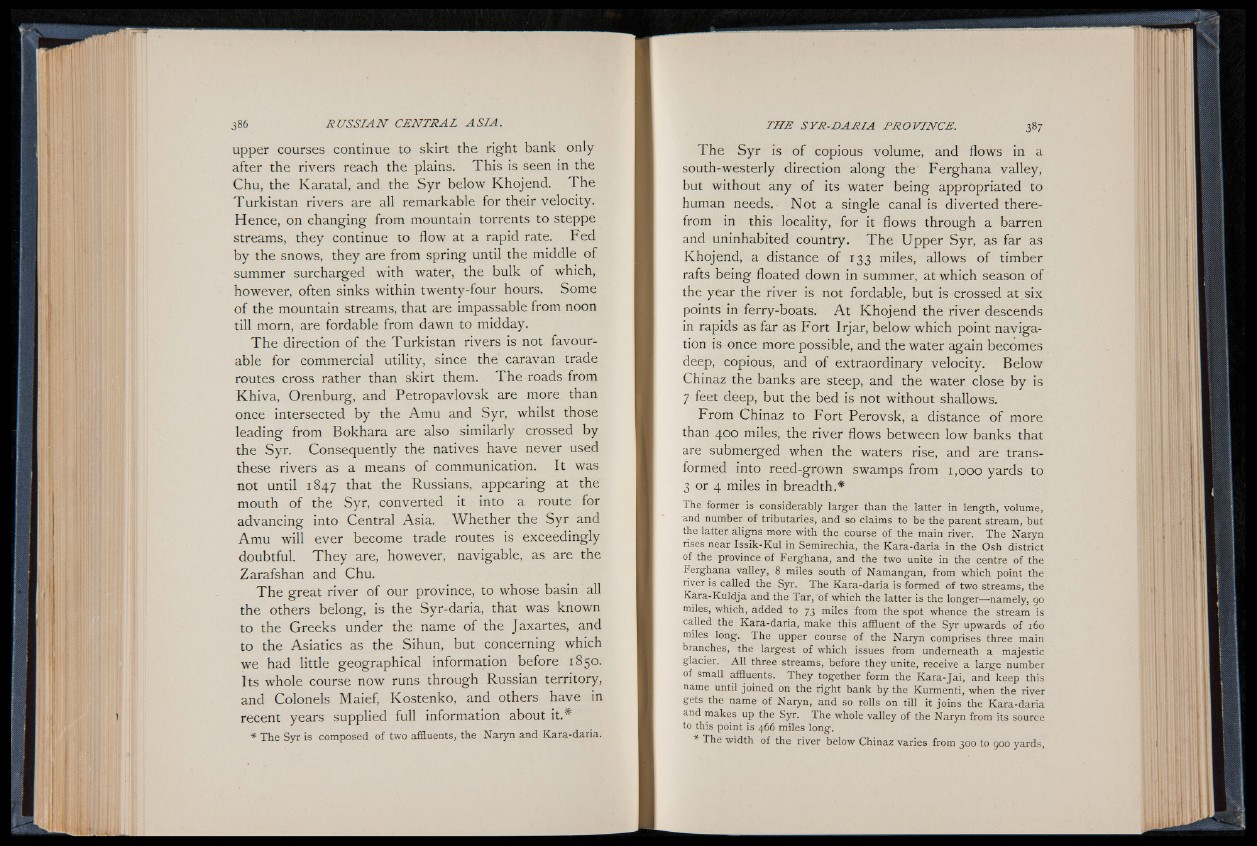
upper courses continue to skirt the right bank only
after the rivers reach the plains. This is seen in the
Chu, the Karatal, and the Syr below Khojend. The
Turkistan rivers are all remarkable for their velocity.
Hence, on changing from mountain torrents to steppe
streams, they continue to flow at a rapid rate. Fed
by the snows, they are from spring until the middle of
summer surcharged with water, the bulk of which,
however, often sinks within twenty-four hours. Some
o f the mountain streams, that are impassable from noon
till morn, are fordable from dawn to midday.
The direction of the Turkistan rivers is not favourable
for commercial utility, since the caravan trade
routes cross rather than skirt them. The roads from
Khiva, Orenburg, and Petropavlovsk are more than
once intersected by the Amu and Syr, whilst those
leading from Bokhara are also similarly crossed by
the Syr. Consequently the natives have never used
these rivers as a means of communication. It was
not until 1847 that the Russians, appearing at the
mouth of the Syr, converted it into a route for
advancing into Central Asia. Whether the Syr and
Amu will ever become trade routes is exceedingly
doubtful. They are, however, navigable, as are the
Zarafshan and Chu.
The great river of our province, to whose basin all
the others belong, is the Syr-daria, that was known
to the Greeks under the name of the Jaxartes, and
to the Asiatics as the Sihun, but concerning which
we had little geographical information before 1850.
Its whole course now runs through Russian territory,
and Colonels Maief, Kostenko, and others have in
recent years supplied full information about it.#
* The Syr is composed of two affluents, the Naryn and Kara-daria.
The Syr is of copious volume, and flows in a
south-westerly direction along the Ferghana valley,
but without any of its water being appropriated to
human needs. ■ Not a single canal is diverted therefrom
in this locality, for it flows through a barren
and uninhabited country. The Upper Syr, as far as
Khojend, a distance of 133 miles, allows of timber
rafts being floated down in summer, at which season of
the year the river is not fordable, but is crossed at six
points in ferry-boats. A t Khojend the river descends
in rapids as far as Fort Irjar, below which point navigation
is once more possible, and the water again becomes
deep, copious, and of extraordinary velocity. Below
Chinaz the banks are steep, and the water close by is
7 feet deep, but the bed is not without shallows.
From Chinaz to Fort Perovsk, a distance of more
than 400 miles, the river flows between low banks that
are submerged when the waters rise, and are transformed
into reed-grown swamps from 1,000 yards to
3 or 4 miles in breadth.*
The former is considerably larger than the latter in length, volume,
and number of tributaries, and so claims to be the parent stream, but
the latter aligns more with the course of the main river. The Naryn
rises near Issik-Kul in Semirechia, the Kara-daria in the Osh district
of the province of Ferghana, and the two unite in the centre of the
Ferghana valley, 8 miles south of Namangan, from which point the
river is called the Syr. The Kara-daria is formed of two streams, the
Kara-Kulclja and the Tar, of which the latter is the longer—-namely, go
miles, which, added to 73 miles from the spot whence the stream is
called the Kara-daria, make this affluent of the Syr upwards of 160
miles long. The upper course of the Naryn comprises three main
branches, the largest of which issues from underneath a majestic
glacier. A ll three streams, before they unite, receive a large number
of Small affluents. They together form the Kara-Jai, and keep this
name until joined on the right bank by the Kurmenti, when the river
gets the name of Naryn, and so rolls on till it joins the Kara-daria
and makes up the Syr. The whole valley of the Naryn from its source
to this point is 466 miles long.
* The width of the river below Chinaz varies from 300 to goo yards,